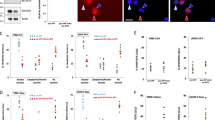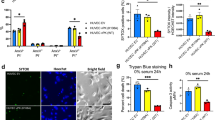Abstract
Activated double-stranded RNA (dsRNA)–dependent protein kinase PKR is a potent growth inhibitory protein that is primarily activated in virally infected cells, inducing cell death. Here we investigate whether selective activation of PKR can be used to kill cancer cells that express mutated genes containing deletions or chromosomal translocations. We show that antisense (AS) RNA complementary to fragments flanking the deletion or translocation can produce a dsRNA molecule of sufficient length to activate PKR and induce cell death following hybridization with mutated but not wild-type mRNA. Using the U87MGΔEGFR cell line, which expresses a truncated form of epidermal growth factor receptor (EGFR), Δ(2-7) EGFR, we found that expression of a 39-nucleotide (nt) AS RNA complementary to the unique exon 1 to 8 junction caused selective death of cells harboring the truncated EGFR both in vitro and in vivo but did not affect cells expressing wild-type EGFR. A lentiviral vector expressing the 39-nt AS sequence strongly inhibited glioblastoma growth in mouse brain when injected after tumor cell implantation. This PKR-mediated killing strategy may be useful in treating many cancers that express a unique RNA species.
This is a preview of subscription content, access via your institution
Access options
Subscribe to this journal
Receive 12 print issues and online access
$209.00 per year
only $17.42 per issue
Buy this article
- Purchase on Springer Link
- Instant access to full article PDF
Prices may be subject to local taxes which are calculated during checkout







Similar content being viewed by others
References
Farrell, P.J. et al. Interferon action: two distinct pathways for inhibition of protein synthesis by double-stranded RNA. Proc. Natl. Acad. Sci. USA 75, 5893–5897 (1978).
Jagus, R., Joshi, B. & Barber, G.N. PKR, apoptosis and cancer. Int. J. Biochem. Cell Biol. 31, 123–138 (1999).
Wu, S. & Kaufman, R.J. A model for the double-stranded RNA (dsRNA)-dependent dimerization and activation of the dsRNA-activated protein kinase PKR. J. Biol. Chem. 272, 1291–1296 (1997).
Manche, L., Green, S.R., Schmedt, C. & Mathews, M.B. Interactions between double-stranded RNA regulators and the protein kinase DAI. Mol. Cell. Biol. 12, 5238–5248 (1992).
Nishikawa, R. et al. A mutant epidermal growth factor receptor common in human glioma confers enhanced tumorigenicity. Proc. Natl. Acad. Sci. USA 91, 7727–7731 (1994).
Nagane, M., Levitzki, A., Gazit, A., Cavenee, W.K. & Huang, H.J. Drug resistance of human glioblastoma cells conferred by a tumor-specific mutant epidermal growth factor receptor through modulation of Bcl-XL and caspase-3-like proteases. Proc. Natl. Acad. Sci. USA 95, 5724–5729 (1998).
He, Y. et al. Inhibition of human squamous cell carcinoma growth in vivo by epidermal growth factor receptor antisense RNA transcribed from the U6 promoter. J. Natl. Cancer Inst. 90, 1080–1087 (1998).
Naldini, L. & Verma, I.M. Lentiviral vectors. Adv. Virus Res. 55, 599–609 (2000).
Hu, Y. & Conway, T.W. 2-Aminopurine inhibits the double-stranded RNA-dependent protein kinase both in vitro and in vivo. J. Interferon Res. 13, 323–328 (1993).
Koromilas, A.E., Roy, S., Barber, G.N., Katze, M.G. & Sonenberg, N. Malignant transformation by a mutant of the IFNα-inducible dsRNA-dependent protein kinase. Science 257, 1685–1689 (1992).
Davies, M.V., Chang, H.W., Jacobs, B.L. & Kaufman, R.J. The E3L and K3L vaccinia virus gene products stimulate translation through inhibition of the double-stranded RNA-dependent protein kinase by different mechanisms. J. Virol. 67, 1688–1692 (1993).
Denhardt, D.T. Mechanism of action of antisense RNA. Sometime inhibition of transcription, processing, transport, or translation. Ann. NY Acad. Sci. 660, 70–76 (1992).
Elbashir, S.M. et al. Duplexes of 21-nucleotide RNAs mediate RNA interference in cultured mammalian cells. Nature 411, 494–498 (2001).
Player, M.R. & Torrence, P.F. The 2-5A system: modulation of viral and cellular processes through acceleration of RNA degradation. Pharmacol. Ther. 78, 55–113 (1998).
Iordanov, M.S. et al. Activation of p38 mitogen-activated protein kinase and c-Jun NH(2)- terminal kinase by double-stranded RNA and encephalomyocarditis virus: involvement of RNase L, protein kinase R, and alternative pathways. Mol. Cell. Biol. 20, 617–627 (2000).
Li, S., Nagai, K. & Koromilas, A.E. A diminished activation capacity of the interferon-inducible protein kinase PKR in human T lymphocytes. Eur. J. Biochem. 267, 1598–1606 (2000).
Haroun, R.I. & Brem, H. Local drug delivery. Curr. Opin. Oncol. 12, 187–193 (2000).
He, Y. & Huang, L. Growth inhibition of human papillomavirus 16 DNA-positive mouse tumor by antisense RNA transcribed from U6 promoter. Cancer. Res. 5, 3993–3999 (1997).
Bevilacqua, P.C., George, C.X., Samuel, C.E. & Cech, T.R. Binding of the protein kinase PKR to RNAs with secondary structure defects: role of the tandem A-G mismatch and noncontiguous helixes. Biochemistry 37, 6303–6316 (1998).
Zufferey, R., Nagy, D., Mandel, R.J., Naldini, L. & Trono, D. Multiply attenuated lentiviral vector achieves efficient gene delivery in vivo. Nat. Biotechnol. 15, 871–875 (1997).
Naldini, L. et al. In vivo gene delivery and stable transduction of nondividing cells by a lentiviral vector. Science 272, 263–267 (1996).
Hansen, M.B., Nielsen, S.E. & Berg, K. Re-examination and further development of a precise and rapid dye method for measuring cell growth/cell kill. J. Immunol. Methods 119, 203–210 (1989).
Sasaki, M., Wizigmann-Voos, S., Risau, W. & Plate, K.H. Retrovirus producer cells encoding antisense VEGF prolong survival of rats with intracranial GS9L gliomas. Int. J. Dev. Neurosci. 17, 579–591 (1999).
Read, T.A. et al. Local endostatin treatment of gliomas administered by microencapsulated producer cells. Nat. Biotechnol. 19, 29–34 (2001).
Sood, R., Porter, A.C., Olsen, D.A., Cavener, D.R. & Wek, R.C. A mammalian homologue of GCN2 protein kinase important for translational control by phosphorylation of eukaryotic initiation factor-2α. Genetics 154, 787–801 (2000).
Acknowledgements
We acknowledge N. Sonenberg for constructs coding for K3L, E3L, and PKRΔ6 and J. Grandis for U6 expression plasmid. We also thank S. Klein for critical reading of the manuscript. This work was partially supported by Algen Pharmaceuticals.
Author information
Authors and Affiliations
Corresponding author
Ethics declarations
Competing interests
The authors declare no competing financial interests.
Rights and permissions
About this article
Cite this article
Shir, A., Levitzki, A. Inhibition of glioma growth by tumor-specific activation of double-stranded RNA–dependent protein kinase PKR. Nat Biotechnol 20, 895–900 (2002). https://doi.org/10.1038/nbt730
Received:
Accepted:
Published:
Issue Date:
DOI: https://doi.org/10.1038/nbt730
This article is cited by
-
Epidermal growth factor receptor and EGFRvIII in glioblastoma: signaling pathways and targeted therapies
Oncogene (2018)
-
Dicer functions as an antiviral system against human adenoviruses via cleavage of adenovirus-encoded noncoding RNA
Scientific Reports (2016)
-
DNA nanotechnology from the test tube to the cell
Nature Nanotechnology (2015)
-
EGFR signaling-dependent inhibition of glioblastoma growth by ginsenoside Rh2
Tumor Biology (2014)
-
Epidermal Growth Factor Receptor as a Therapeutic Target in Glioblastoma
NeuroMolecular Medicine (2013)



